Analysis of Bullying Effects on Behaviour of University Students
VerifiedAdded on 2023/04/23
|9
|2375
|325
Report
AI Summary
This report investigates the impact of bullying on the behavioral engagement of university students. The research explores the effects of both teacher bullying (TB) and peer bullying (PB) on student behavior, along with a comparison of behavioral engagement between students in state universities and community colleges. The background section defines bullying and highlights its prevalence in various settings, including universities, and its negative impacts on student learning and well-being, such as poor concentration, stress, and academic underachievement. The report outlines research questions, null and alternative hypotheses, and the statistical tests that would be used to analyze data, including reliability analysis, regression analysis, and ANOVA. The methodology includes the use of questionnaires to collect quantitative data from students, focusing on demographics, perceptions of bullying, and behavioral engagement. The significance of the study lies in its contribution to existing literature, particularly in the context of university students, and its potential to inform school stakeholders, policymakers, and educators on strategies to address bullying and foster a conducive learning environment. The study aims to understand the variations in student behavior based on the type of bullying experienced, the institution attended, and ultimately, how to improve the academic and social environment for students.
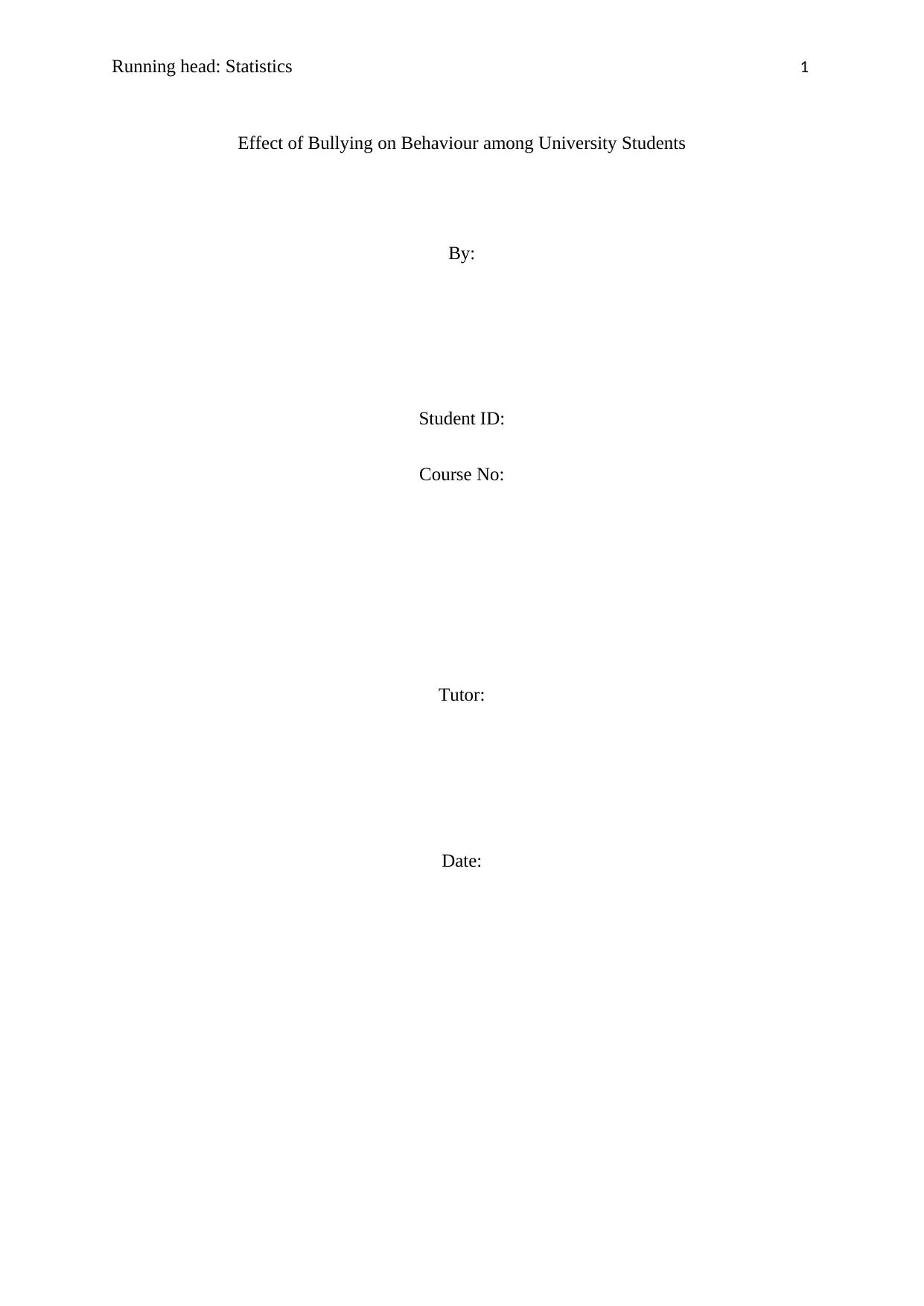
Running head: Statistics 1
Effect of Bullying on Behaviour among University Students
By:
Student ID:
Course No:
Tutor:
Date:
Effect of Bullying on Behaviour among University Students
By:
Student ID:
Course No:
Tutor:
Date:
Paraphrase This Document
Need a fresh take? Get an instant paraphrase of this document with our AI Paraphraser

Statistics 2
Research Questions
1. What is the impact of teacher bullying (TB) on the behaviour of university students?
2. What is the impact of peer bullying (PB) on the behaviour of university students?
3. What is the variation between the behavioural engagement of students in state
universities and community colleges?
Background of the Research Problem
Bullying is a social phenomenon that has globally been observed in all settings of human
interaction such as schools, workplaces and colleges. Thornberg and Jungert (2013) define
bullying as the perceived imbalance in power that is detrimental to the intended victim and is
hostile for the victims. In the context of schools, bullying involves recurrent oppression that
can either be psychological or physical orchestrated by a more powerful individual or group
(Gladden, 2014). Multiple studies have examined bullying and its effect on behavioural
engagement and academic performance in school students (Boulton, Smith, & Cowie, 2010).
Bullying can be caused by teachers or peers. There exist several forms of bullying among
university students such as teasing, threatening, physical injury, theft of one’s property,
taunting and causing social isolation (Hay & Meldrum, 2010). Peer bullying affects the
learning ability and attitude of the students. Danby, Butler, and Emmison (2011) found out
that bullied students developed a poor concentration in class leading to dismal academic
achievement. This is because the victim is more often stressed up and planning on how to
avoid or cope up with bullying from peers. Therefore, most of the victims feel that they are
not fit to be in such an institution and thus prefer to drop out of the institution.
The teacher bullying involves humiliation of the students in front of peers, and the hostile
conduct of the teacher negatively affects the students (Ahmad & Sahak, 2009). Research has
shown that the quality of the association between the teacher and student significantly affects
Research Questions
1. What is the impact of teacher bullying (TB) on the behaviour of university students?
2. What is the impact of peer bullying (PB) on the behaviour of university students?
3. What is the variation between the behavioural engagement of students in state
universities and community colleges?
Background of the Research Problem
Bullying is a social phenomenon that has globally been observed in all settings of human
interaction such as schools, workplaces and colleges. Thornberg and Jungert (2013) define
bullying as the perceived imbalance in power that is detrimental to the intended victim and is
hostile for the victims. In the context of schools, bullying involves recurrent oppression that
can either be psychological or physical orchestrated by a more powerful individual or group
(Gladden, 2014). Multiple studies have examined bullying and its effect on behavioural
engagement and academic performance in school students (Boulton, Smith, & Cowie, 2010).
Bullying can be caused by teachers or peers. There exist several forms of bullying among
university students such as teasing, threatening, physical injury, theft of one’s property,
taunting and causing social isolation (Hay & Meldrum, 2010). Peer bullying affects the
learning ability and attitude of the students. Danby, Butler, and Emmison (2011) found out
that bullied students developed a poor concentration in class leading to dismal academic
achievement. This is because the victim is more often stressed up and planning on how to
avoid or cope up with bullying from peers. Therefore, most of the victims feel that they are
not fit to be in such an institution and thus prefer to drop out of the institution.
The teacher bullying involves humiliation of the students in front of peers, and the hostile
conduct of the teacher negatively affects the students (Ahmad & Sahak, 2009). Research has
shown that the quality of the association between the teacher and student significantly affects

Statistics 3
the behaviour of the learner (Hong & Espelage, 2012). In addition to the peer associations.
Conversely, Lucas‐Molina, Williamson, Pulido, and Pérez‐Albéniz (2015) observe that peer
victimization contributes to the conflicts between teachers and students. The relationship
between peers has a substantial impact on the aggressive conduct of the students. The study
by Garandeau, Ahn, and Rodkin (2011) found out that students who undergo bullying or
seclusion by peers manifest highly aggressive behaviours, and as a result are severely
detached from the class and manifest reduced levels of social preference (Caravita, Di Blasio,
& Salmivalli, 2009).
The TB behaviour consists of any form of unconcealed communication geared towards
psychologically discouraging a learner who is inspired to avoid such behaviour, in addition
verbal or nonverbal assaults on the self-concept of a learner. It can also be noted that bulling
negatively influences the learning ability of students. Longobardi, Spataro, and Rossi-Arnaud
(2016) found out that there exists a significant emotional and relational association between
teachers and students. Multiple studies have also shown that student-teacher relationships
affect a student’s behavioural engagement (Longobardi et al., 2016; Hughes & Im, 2016).
The bullying conduct that is most common among teachers consists of the abuse of power
(Sylvester, 2011). If the teachers bully their students, they are forced to lose focus on their
main objective which is excelling in academics. The communication pattern between the
learners and the instructors is also impaired by the bullying behaviour of the teacher.
Consequently, the students become disengaged leading to student resistance and involvement
in the class room. The student will prefer to keep silent due to the aggressive conduct of the
instructor. There exists minimal literature on student disengagement as a result of bullying.
Most studies have focused on the impact of student-teachers associations on bullying.
According to Roth, Kanat‐Maymon, and Bibi (2011) the teacher’s behaviour has a long-term
the behaviour of the learner (Hong & Espelage, 2012). In addition to the peer associations.
Conversely, Lucas‐Molina, Williamson, Pulido, and Pérez‐Albéniz (2015) observe that peer
victimization contributes to the conflicts between teachers and students. The relationship
between peers has a substantial impact on the aggressive conduct of the students. The study
by Garandeau, Ahn, and Rodkin (2011) found out that students who undergo bullying or
seclusion by peers manifest highly aggressive behaviours, and as a result are severely
detached from the class and manifest reduced levels of social preference (Caravita, Di Blasio,
& Salmivalli, 2009).
The TB behaviour consists of any form of unconcealed communication geared towards
psychologically discouraging a learner who is inspired to avoid such behaviour, in addition
verbal or nonverbal assaults on the self-concept of a learner. It can also be noted that bulling
negatively influences the learning ability of students. Longobardi, Spataro, and Rossi-Arnaud
(2016) found out that there exists a significant emotional and relational association between
teachers and students. Multiple studies have also shown that student-teacher relationships
affect a student’s behavioural engagement (Longobardi et al., 2016; Hughes & Im, 2016).
The bullying conduct that is most common among teachers consists of the abuse of power
(Sylvester, 2011). If the teachers bully their students, they are forced to lose focus on their
main objective which is excelling in academics. The communication pattern between the
learners and the instructors is also impaired by the bullying behaviour of the teacher.
Consequently, the students become disengaged leading to student resistance and involvement
in the class room. The student will prefer to keep silent due to the aggressive conduct of the
instructor. There exists minimal literature on student disengagement as a result of bullying.
Most studies have focused on the impact of student-teachers associations on bullying.
According to Roth, Kanat‐Maymon, and Bibi (2011) the teacher’s behaviour has a long-term
⊘ This is a preview!⊘
Do you want full access?
Subscribe today to unlock all pages.

Trusted by 1+ million students worldwide
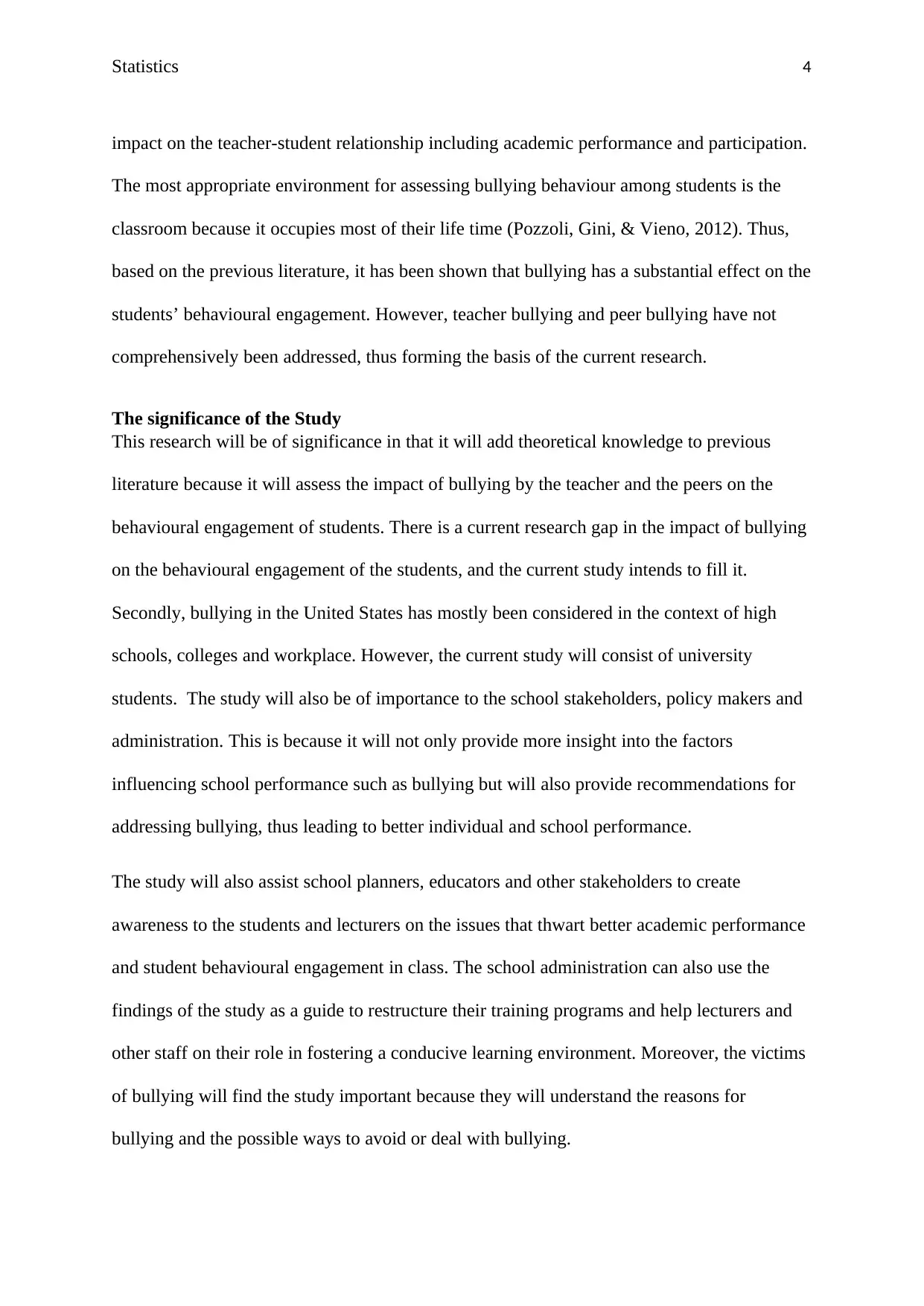
Statistics 4
impact on the teacher-student relationship including academic performance and participation.
The most appropriate environment for assessing bullying behaviour among students is the
classroom because it occupies most of their life time (Pozzoli, Gini, & Vieno, 2012). Thus,
based on the previous literature, it has been shown that bullying has a substantial effect on the
students’ behavioural engagement. However, teacher bullying and peer bullying have not
comprehensively been addressed, thus forming the basis of the current research.
The significance of the Study
This research will be of significance in that it will add theoretical knowledge to previous
literature because it will assess the impact of bullying by the teacher and the peers on the
behavioural engagement of students. There is a current research gap in the impact of bullying
on the behavioural engagement of the students, and the current study intends to fill it.
Secondly, bullying in the United States has mostly been considered in the context of high
schools, colleges and workplace. However, the current study will consist of university
students. The study will also be of importance to the school stakeholders, policy makers and
administration. This is because it will not only provide more insight into the factors
influencing school performance such as bullying but will also provide recommendations for
addressing bullying, thus leading to better individual and school performance.
The study will also assist school planners, educators and other stakeholders to create
awareness to the students and lecturers on the issues that thwart better academic performance
and student behavioural engagement in class. The school administration can also use the
findings of the study as a guide to restructure their training programs and help lecturers and
other staff on their role in fostering a conducive learning environment. Moreover, the victims
of bullying will find the study important because they will understand the reasons for
bullying and the possible ways to avoid or deal with bullying.
impact on the teacher-student relationship including academic performance and participation.
The most appropriate environment for assessing bullying behaviour among students is the
classroom because it occupies most of their life time (Pozzoli, Gini, & Vieno, 2012). Thus,
based on the previous literature, it has been shown that bullying has a substantial effect on the
students’ behavioural engagement. However, teacher bullying and peer bullying have not
comprehensively been addressed, thus forming the basis of the current research.
The significance of the Study
This research will be of significance in that it will add theoretical knowledge to previous
literature because it will assess the impact of bullying by the teacher and the peers on the
behavioural engagement of students. There is a current research gap in the impact of bullying
on the behavioural engagement of the students, and the current study intends to fill it.
Secondly, bullying in the United States has mostly been considered in the context of high
schools, colleges and workplace. However, the current study will consist of university
students. The study will also be of importance to the school stakeholders, policy makers and
administration. This is because it will not only provide more insight into the factors
influencing school performance such as bullying but will also provide recommendations for
addressing bullying, thus leading to better individual and school performance.
The study will also assist school planners, educators and other stakeholders to create
awareness to the students and lecturers on the issues that thwart better academic performance
and student behavioural engagement in class. The school administration can also use the
findings of the study as a guide to restructure their training programs and help lecturers and
other staff on their role in fostering a conducive learning environment. Moreover, the victims
of bullying will find the study important because they will understand the reasons for
bullying and the possible ways to avoid or deal with bullying.
Paraphrase This Document
Need a fresh take? Get an instant paraphrase of this document with our AI Paraphraser
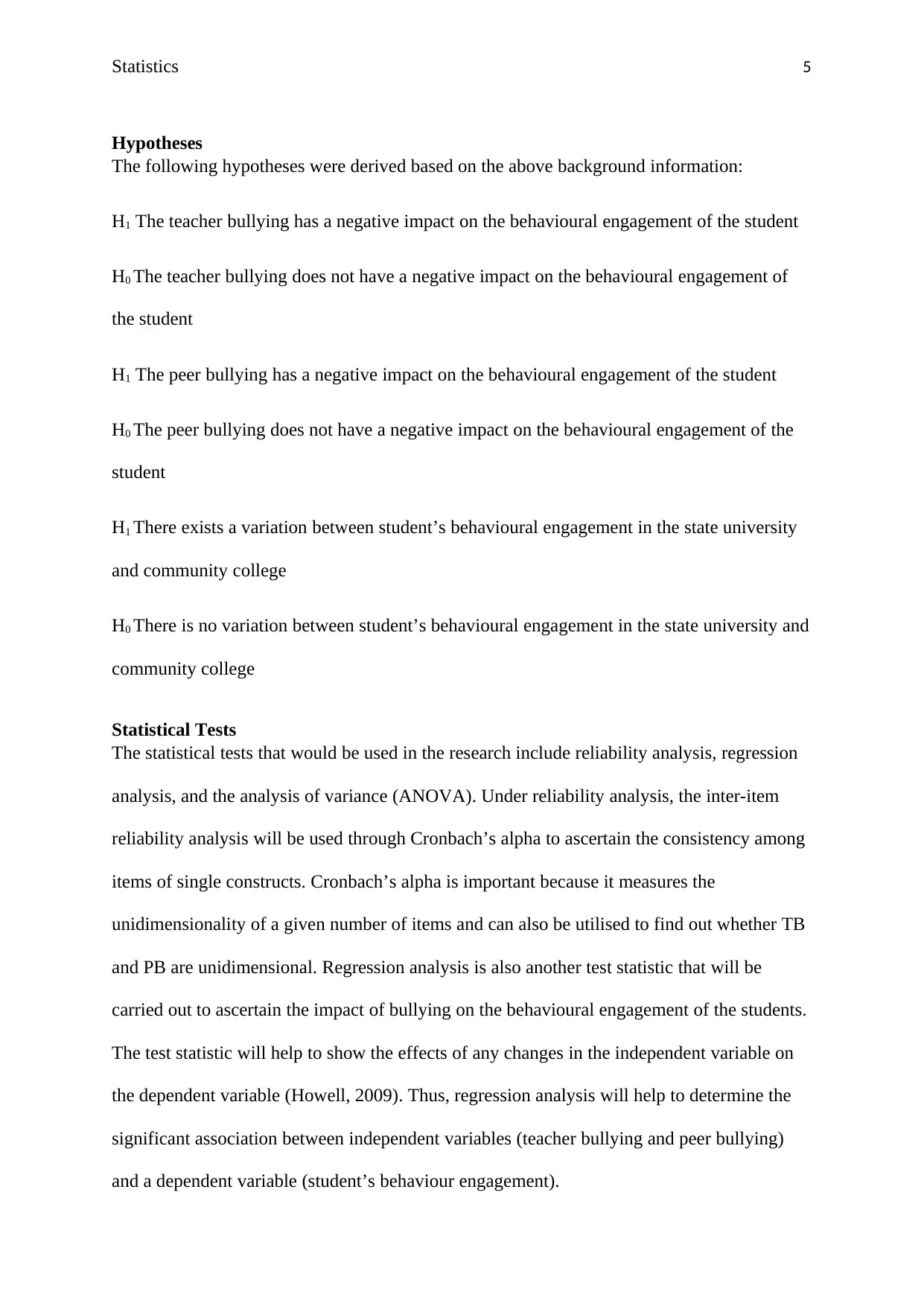
Statistics 5
Hypotheses
The following hypotheses were derived based on the above background information:
H1 The teacher bullying has a negative impact on the behavioural engagement of the student
H0 The teacher bullying does not have a negative impact on the behavioural engagement of
the student
H1 The peer bullying has a negative impact on the behavioural engagement of the student
H0 The peer bullying does not have a negative impact on the behavioural engagement of the
student
H1 There exists a variation between student’s behavioural engagement in the state university
and community college
H0 There is no variation between student’s behavioural engagement in the state university and
community college
Statistical Tests
The statistical tests that would be used in the research include reliability analysis, regression
analysis, and the analysis of variance (ANOVA). Under reliability analysis, the inter-item
reliability analysis will be used through Cronbach’s alpha to ascertain the consistency among
items of single constructs. Cronbach’s alpha is important because it measures the
unidimensionality of a given number of items and can also be utilised to find out whether TB
and PB are unidimensional. Regression analysis is also another test statistic that will be
carried out to ascertain the impact of bullying on the behavioural engagement of the students.
The test statistic will help to show the effects of any changes in the independent variable on
the dependent variable (Howell, 2009). Thus, regression analysis will help to determine the
significant association between independent variables (teacher bullying and peer bullying)
and a dependent variable (student’s behaviour engagement).
Hypotheses
The following hypotheses were derived based on the above background information:
H1 The teacher bullying has a negative impact on the behavioural engagement of the student
H0 The teacher bullying does not have a negative impact on the behavioural engagement of
the student
H1 The peer bullying has a negative impact on the behavioural engagement of the student
H0 The peer bullying does not have a negative impact on the behavioural engagement of the
student
H1 There exists a variation between student’s behavioural engagement in the state university
and community college
H0 There is no variation between student’s behavioural engagement in the state university and
community college
Statistical Tests
The statistical tests that would be used in the research include reliability analysis, regression
analysis, and the analysis of variance (ANOVA). Under reliability analysis, the inter-item
reliability analysis will be used through Cronbach’s alpha to ascertain the consistency among
items of single constructs. Cronbach’s alpha is important because it measures the
unidimensionality of a given number of items and can also be utilised to find out whether TB
and PB are unidimensional. Regression analysis is also another test statistic that will be
carried out to ascertain the impact of bullying on the behavioural engagement of the students.
The test statistic will help to show the effects of any changes in the independent variable on
the dependent variable (Howell, 2009). Thus, regression analysis will help to determine the
significant association between independent variables (teacher bullying and peer bullying)
and a dependent variable (student’s behaviour engagement).
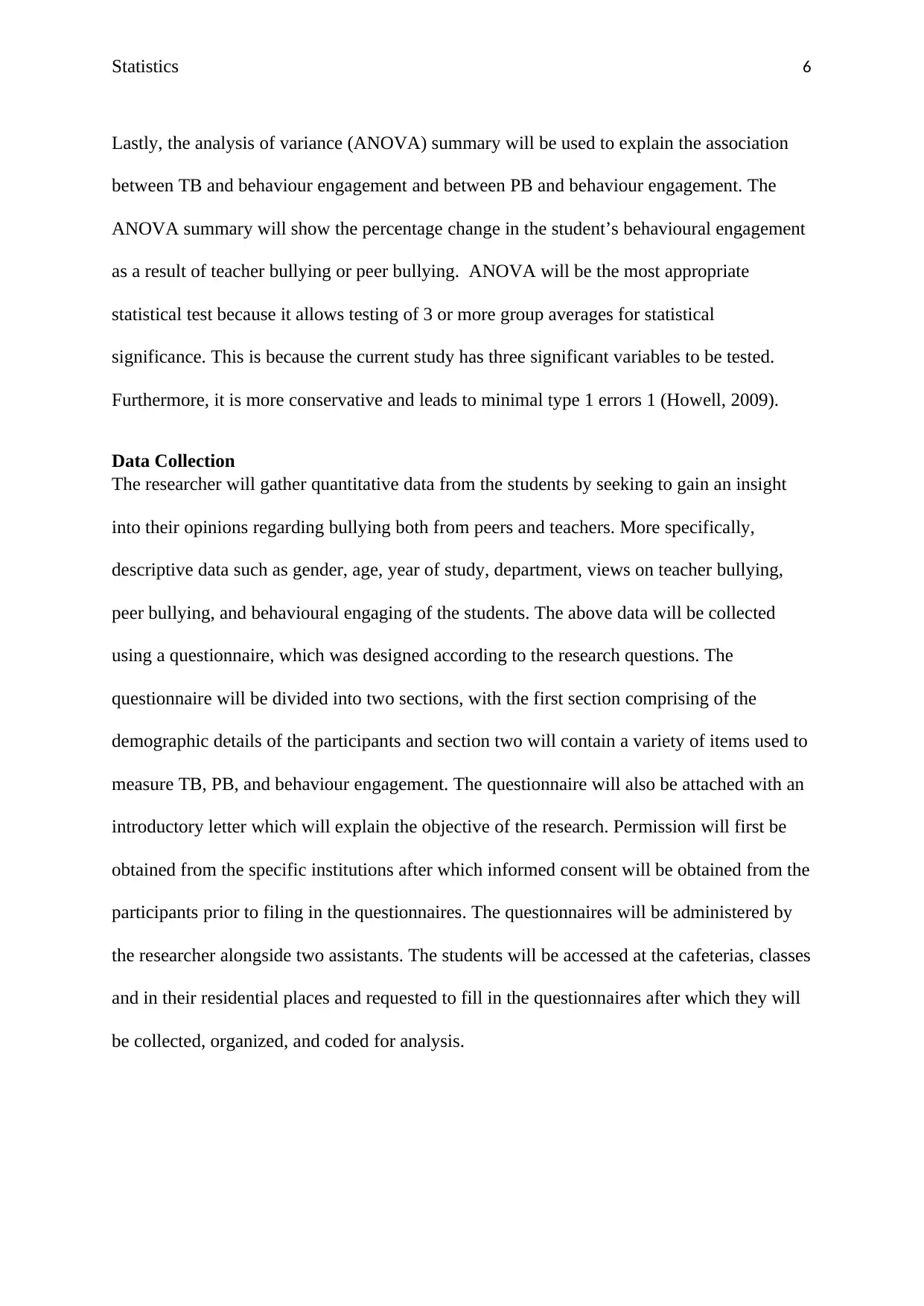
Statistics 6
Lastly, the analysis of variance (ANOVA) summary will be used to explain the association
between TB and behaviour engagement and between PB and behaviour engagement. The
ANOVA summary will show the percentage change in the student’s behavioural engagement
as a result of teacher bullying or peer bullying. ANOVA will be the most appropriate
statistical test because it allows testing of 3 or more group averages for statistical
significance. This is because the current study has three significant variables to be tested.
Furthermore, it is more conservative and leads to minimal type 1 errors 1 (Howell, 2009).
Data Collection
The researcher will gather quantitative data from the students by seeking to gain an insight
into their opinions regarding bullying both from peers and teachers. More specifically,
descriptive data such as gender, age, year of study, department, views on teacher bullying,
peer bullying, and behavioural engaging of the students. The above data will be collected
using a questionnaire, which was designed according to the research questions. The
questionnaire will be divided into two sections, with the first section comprising of the
demographic details of the participants and section two will contain a variety of items used to
measure TB, PB, and behaviour engagement. The questionnaire will also be attached with an
introductory letter which will explain the objective of the research. Permission will first be
obtained from the specific institutions after which informed consent will be obtained from the
participants prior to filing in the questionnaires. The questionnaires will be administered by
the researcher alongside two assistants. The students will be accessed at the cafeterias, classes
and in their residential places and requested to fill in the questionnaires after which they will
be collected, organized, and coded for analysis.
Lastly, the analysis of variance (ANOVA) summary will be used to explain the association
between TB and behaviour engagement and between PB and behaviour engagement. The
ANOVA summary will show the percentage change in the student’s behavioural engagement
as a result of teacher bullying or peer bullying. ANOVA will be the most appropriate
statistical test because it allows testing of 3 or more group averages for statistical
significance. This is because the current study has three significant variables to be tested.
Furthermore, it is more conservative and leads to minimal type 1 errors 1 (Howell, 2009).
Data Collection
The researcher will gather quantitative data from the students by seeking to gain an insight
into their opinions regarding bullying both from peers and teachers. More specifically,
descriptive data such as gender, age, year of study, department, views on teacher bullying,
peer bullying, and behavioural engaging of the students. The above data will be collected
using a questionnaire, which was designed according to the research questions. The
questionnaire will be divided into two sections, with the first section comprising of the
demographic details of the participants and section two will contain a variety of items used to
measure TB, PB, and behaviour engagement. The questionnaire will also be attached with an
introductory letter which will explain the objective of the research. Permission will first be
obtained from the specific institutions after which informed consent will be obtained from the
participants prior to filing in the questionnaires. The questionnaires will be administered by
the researcher alongside two assistants. The students will be accessed at the cafeterias, classes
and in their residential places and requested to fill in the questionnaires after which they will
be collected, organized, and coded for analysis.
⊘ This is a preview!⊘
Do you want full access?
Subscribe today to unlock all pages.

Trusted by 1+ million students worldwide

Statistics 7
References
Ahmad, A., & Sahak, R. (2009). Teacher-Student Attachment And Teachers'attitudes
Towards Work. Journal of Educators & Education/Jurnal Pendidik dan
Pendidikan, 24 55-72.
Boulton, M. J., Smith, P. K., & Cowie, H. (2010). Short-term longitudinal relationships
between children’s peer victimization/bullying experiences and self-perceptions:
Evidence for reciprocity. School Psychology International, 31(3), 296-311.
Caravita, S. C., Di Blasio, P., & Salmivalli, C. (2009). Unique and interactive effects of
empathy and social status on involvement in bullying. Social development, 18(1),
140-163.
Danby, S., Butler, C. W., & Emmison, M. (2011). ‘Have you talked with a teacher yet?’:
How helpline counsellors support young callers being bullied at school. Children &
Society, 25(4), 328-339.
Garandeau, C. F., Ahn, H. J., & Rodkin, P. C. (2011). The social status of aggressive students
across contexts: The role of classroom status hierarchy, academic achievement, and
grade. Developmental psychology, 47(6), 1699-1707.
Gladden, R. M. (2014). Bullying Surveillance among Youths: Uniform Definitions for Public
Health and Recommended Data Elements. Version 1.0. Centers for Disease Control
and Prevention, 1, 7-12.
Hay, C., & Meldrum, R. (2010). Bullying victimization and adolescent self-harm: Testing
References
Ahmad, A., & Sahak, R. (2009). Teacher-Student Attachment And Teachers'attitudes
Towards Work. Journal of Educators & Education/Jurnal Pendidik dan
Pendidikan, 24 55-72.
Boulton, M. J., Smith, P. K., & Cowie, H. (2010). Short-term longitudinal relationships
between children’s peer victimization/bullying experiences and self-perceptions:
Evidence for reciprocity. School Psychology International, 31(3), 296-311.
Caravita, S. C., Di Blasio, P., & Salmivalli, C. (2009). Unique and interactive effects of
empathy and social status on involvement in bullying. Social development, 18(1),
140-163.
Danby, S., Butler, C. W., & Emmison, M. (2011). ‘Have you talked with a teacher yet?’:
How helpline counsellors support young callers being bullied at school. Children &
Society, 25(4), 328-339.
Garandeau, C. F., Ahn, H. J., & Rodkin, P. C. (2011). The social status of aggressive students
across contexts: The role of classroom status hierarchy, academic achievement, and
grade. Developmental psychology, 47(6), 1699-1707.
Gladden, R. M. (2014). Bullying Surveillance among Youths: Uniform Definitions for Public
Health and Recommended Data Elements. Version 1.0. Centers for Disease Control
and Prevention, 1, 7-12.
Hay, C., & Meldrum, R. (2010). Bullying victimization and adolescent self-harm: Testing
Paraphrase This Document
Need a fresh take? Get an instant paraphrase of this document with our AI Paraphraser
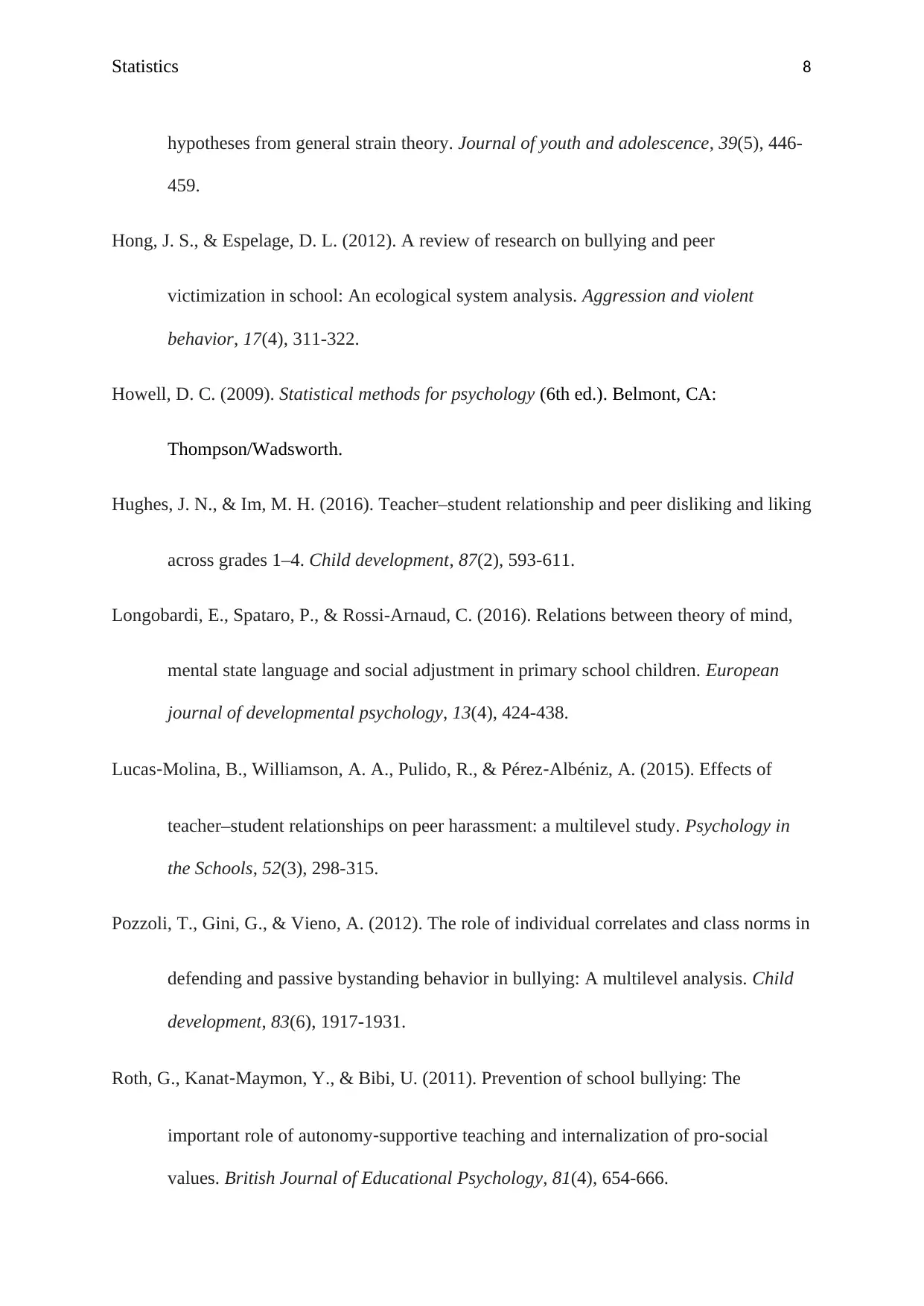
Statistics 8
hypotheses from general strain theory. Journal of youth and adolescence, 39(5), 446-
459.
Hong, J. S., & Espelage, D. L. (2012). A review of research on bullying and peer
victimization in school: An ecological system analysis. Aggression and violent
behavior, 17(4), 311-322.
Howell, D. C. (2009). Statistical methods for psychology (6th ed.). Belmont, CA:
Thompson/Wadsworth.
Hughes, J. N., & Im, M. H. (2016). Teacher–student relationship and peer disliking and liking
across grades 1–4. Child development, 87(2), 593-611.
Longobardi, E., Spataro, P., & Rossi-Arnaud, C. (2016). Relations between theory of mind,
mental state language and social adjustment in primary school children. European
journal of developmental psychology, 13(4), 424-438.
Lucas‐Molina, B., Williamson, A. A., Pulido, R., & Pérez‐Albéniz, A. (2015). Effects of
teacher–student relationships on peer harassment: a multilevel study. Psychology in
the Schools, 52(3), 298-315.
Pozzoli, T., Gini, G., & Vieno, A. (2012). The role of individual correlates and class norms in
defending and passive bystanding behavior in bullying: A multilevel analysis. Child
development, 83(6), 1917-1931.
Roth, G., Kanat‐Maymon, Y., & Bibi, U. (2011). Prevention of school bullying: The
important role of autonomy‐supportive teaching and internalization of pro‐social
values. British Journal of Educational Psychology, 81(4), 654-666.
hypotheses from general strain theory. Journal of youth and adolescence, 39(5), 446-
459.
Hong, J. S., & Espelage, D. L. (2012). A review of research on bullying and peer
victimization in school: An ecological system analysis. Aggression and violent
behavior, 17(4), 311-322.
Howell, D. C. (2009). Statistical methods for psychology (6th ed.). Belmont, CA:
Thompson/Wadsworth.
Hughes, J. N., & Im, M. H. (2016). Teacher–student relationship and peer disliking and liking
across grades 1–4. Child development, 87(2), 593-611.
Longobardi, E., Spataro, P., & Rossi-Arnaud, C. (2016). Relations between theory of mind,
mental state language and social adjustment in primary school children. European
journal of developmental psychology, 13(4), 424-438.
Lucas‐Molina, B., Williamson, A. A., Pulido, R., & Pérez‐Albéniz, A. (2015). Effects of
teacher–student relationships on peer harassment: a multilevel study. Psychology in
the Schools, 52(3), 298-315.
Pozzoli, T., Gini, G., & Vieno, A. (2012). The role of individual correlates and class norms in
defending and passive bystanding behavior in bullying: A multilevel analysis. Child
development, 83(6), 1917-1931.
Roth, G., Kanat‐Maymon, Y., & Bibi, U. (2011). Prevention of school bullying: The
important role of autonomy‐supportive teaching and internalization of pro‐social
values. British Journal of Educational Psychology, 81(4), 654-666.
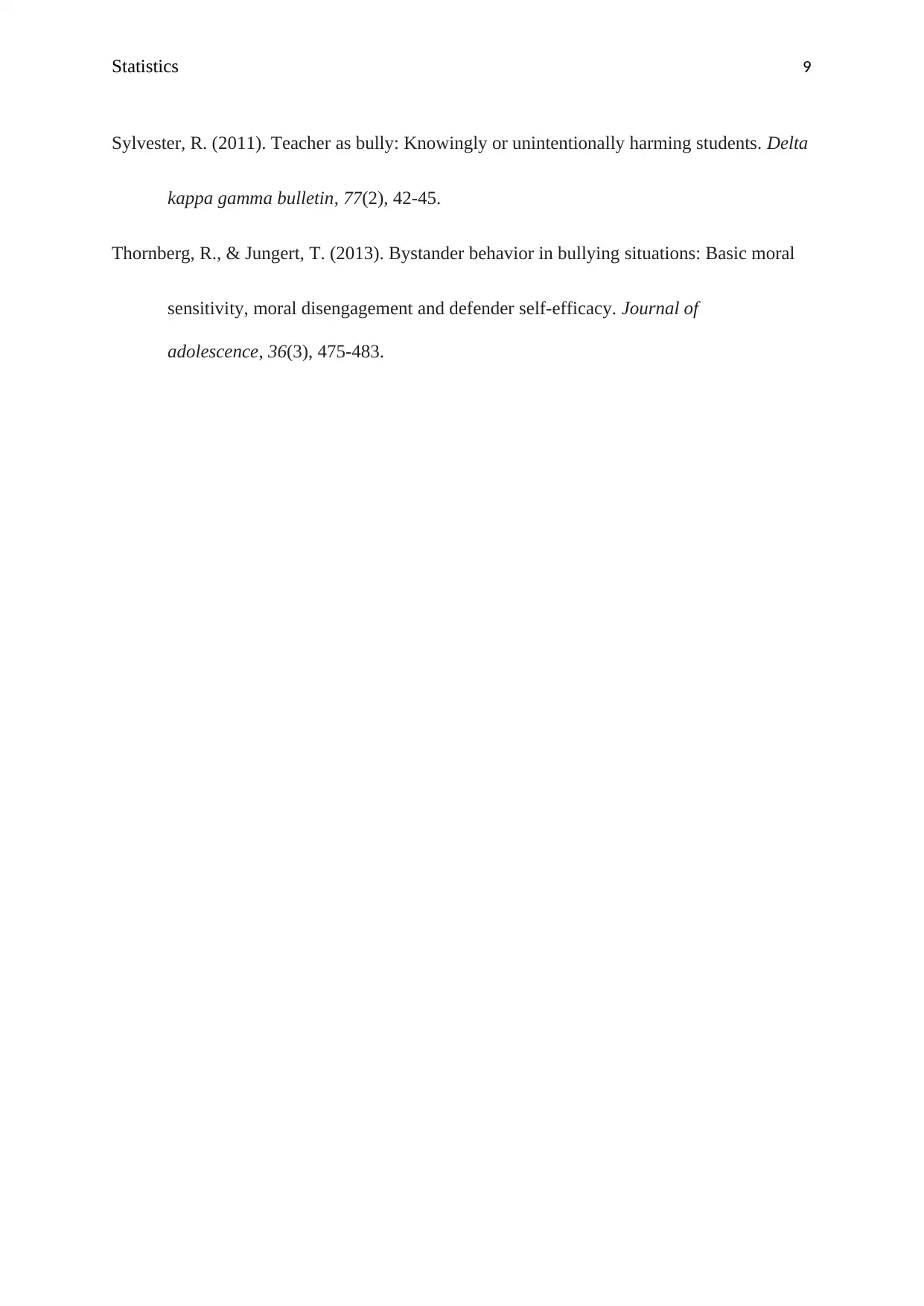
Statistics 9
Sylvester, R. (2011). Teacher as bully: Knowingly or unintentionally harming students. Delta
kappa gamma bulletin, 77(2), 42-45.
Thornberg, R., & Jungert, T. (2013). Bystander behavior in bullying situations: Basic moral
sensitivity, moral disengagement and defender self-efficacy. Journal of
adolescence, 36(3), 475-483.
Sylvester, R. (2011). Teacher as bully: Knowingly or unintentionally harming students. Delta
kappa gamma bulletin, 77(2), 42-45.
Thornberg, R., & Jungert, T. (2013). Bystander behavior in bullying situations: Basic moral
sensitivity, moral disengagement and defender self-efficacy. Journal of
adolescence, 36(3), 475-483.
⊘ This is a preview!⊘
Do you want full access?
Subscribe today to unlock all pages.

Trusted by 1+ million students worldwide
1 out of 9
Related Documents
Your All-in-One AI-Powered Toolkit for Academic Success.
+13062052269
info@desklib.com
Available 24*7 on WhatsApp / Email
![[object Object]](/_next/static/media/star-bottom.7253800d.svg)
Unlock your academic potential
Copyright © 2020–2025 A2Z Services. All Rights Reserved. Developed and managed by ZUCOL.





